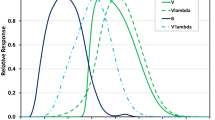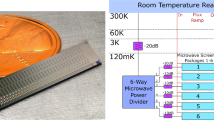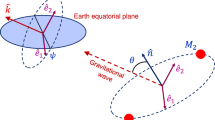Kavli Institute for the Physics and Mathematics of the Universe (Kavli IPMU, WPI), UTIAS, The University of Tokyo, Kashiwa, Chiba, 277-8583, Japan
T. Hasebe, S. Azzoni, Y. Chinone, W. Coulton, A. Ducout, T. Ghigna, M. Hazumi, N. Katayama, T. Matsumura, Y. Sakurai, S. Stever & S. Takakura
School of Physics and Astronomy, Cardiff University, Cardiff, CF10 3XQ, UK
P. A. R. Ade, E. Calabrese, P. Hargrave, F. Noviello & C. Tucker
Department of Physics, The Oskar Klein Centre, Stockholm University, 106 91, Stockholm, Sweden
A. Adler, K. Dachlythra & J. E. Gudmundsson
Laboratoire de Physique de l’ École Normale Sup´erieure, ENS, Université PSL, CNRS, Sorbonne Université, Université de Paris, 75005, Paris, France
E. Allys, F. Boulanger, F. Levrier & A. Ritacco
Department of Physics, University of Oxford, Denys Wilkinson Building, Keble Road, Oxford, OX1 3RH, UK
D. Alonso, S. Azzoni, T. Ghigna, M. Jones, A. Taylor & B. Thorne
Department of Physics, University of California, San Diego, San Diego, CA, 92093-0424, USA
K. Arnold, R. Flauger, M. Russell & J. Seibert
CNRS/IN2P3, IJCLab, Université Paris-Saclay, 91405, Orsay, France
D. Auguste, J. Bonis, D. Douillet, S. Henrot-Versillé, G. Laquaniello, T. Louis, J. Peloton & M. Tristram
IRAP, Université de Toulouse, CNRS, CNES, UPS, Toulouse, France
J. Aumont, A. J. Banday, L. Bautista, L. Montier, B. Mot, D. Rambaud, G. Roudil & L. Vacher
Institute of Theoretical Astrophysics, University of Oslo, Blindern, Oslo, Norway
R. Aurlien, R. Banerji, M. Brilenkov, H. K. Eriksen, U. Fuskeland, M. Galloway, E. Gjerløw, D. Herman, T. L. Svalheim, H. Thommesen & I. K. Wehus
National Institute of Standards and Technology (NIST), Boulder, CO, 80305, USA
J. Austermann, J. Beall, S. Duff, G. Hilton, J. Hubmayr, J. V. Lanen, J. Ullom & M. Vissers
International School for Advanced Studies (SISSA), Via Bonomea 265, 34136, Trieste, Italy
C. Baccigalupi & N. Krachmalnicoff
INFN Sezione di Trieste, Via Valerio 2, 34127, Trieste, Italy
C. Baccigalupi & N. Krachmalnicoff
IFPU, Via Beirut, 2, 34151, Grignano, Trieste, Italy
C. Baccigalupi & N. Krachmalnicoff
Instituto de Fisica de Cantabria (IFCA, CSIC-UC), Avenida los Castros SN, 39005, Santander, Spain
R. B. Barreiro, F. J. Casas, E. de la Hoz, P. Diego-Palazuelos, D. Herranz, E. Martínez-González & P. Vielva
Dipartimento di Fisica e Astronomia “G. Galilei”, Universita ‘ degli Studi di Padova, Via Marzolo 8, 35131, Padova, Italy
N. Bartolo & S. Matarrese
INFN Sezione di Padova, Via Marzolo 8, 35131, Padova, Italy
N. Bartolo & S. Matarrese
School of Physics, Indian Institute of Science Education and Research Thiruvananthapuram, Maruthamala PO, Vithura, Thiruvananthapuram, Kerala, 695551, India
S. Basak
Dipartimento di Fisica, Università La Sapienza, P. le A. Moro 2, Rome, Italy
E. Battistelli, F. Columbro, G. D’Alessandro, P. de Bernardis, M. De Petris, L. Lamagna, S. Masi, L. Mele, A. Paiella, F. Piacentini & G. Pisano
INFN Sezione di Roma, P.le A. Moro 2, 00185, Rome, Italy
E. Battistelli, F. Columbro, G. D’Alessandro, P. de Bernardis, M. De Petris, L. Lamagna, S. Masi, L. Mele, A. Paiella & F. Piacentini
Department of Physics, Stanford University, Stanford, CA, 94305-4060, USA
D. Beck, A. Cukierman, C. L. Kuo & K. L. Thompson
Department of Physics, University of California, Berkeley, Berkeley, CA, 94720, USA
S. Beckman, K. Cheung, A. Cukierman, C. A. Hill, A. L. Hornsby, R. Keskitalo, A. T. Lee, C. Raum, E. Taylor & B. Westbrook
Institut d’Astrophysique de Paris, CNRS/Sorbonne Université, Paris, France
K. Benabed, F. Bouchet, S. Galli, E. Hivon & B. Wandelt
Instituto Universitario “Ignacio Da Riva” (IDR/UPM), Universidad Politécnica de Madrid, Plaza Cardenal Cisneros, 3, 28040, Madrid, Spain
J. Bermejo-Ballesteros & J. Cubas
Dipartimento di Fisica, Universita’ degli Studi di Milano, Via Celoria 16, 20133, Milan, Italy
M. Bersanelli, C. Franceschet, D. Maino, S. Mandelli, A. Mennella, S. Realini & M. Tomasi
INFN Sezione di Milano, Via Celoria 16, 20133, Milan, Italy
M. Bersanelli, C. Franceschet, S. Mandelli, A. Mennella & M. Tomasi
Computational Cosmology Center, Lawrence Berkeley National Laboratory (LBNL), Berkeley, CA, 94720, USA
J. Borrill, K. Cheung, T. Elleflot, R. Keskitalo, T. Kisner & A. Suzuki
CNRS, Institut d’Astrophysique Spatiale, Université Paris-Saclay, 91405, Orsay, France
S. Bounissou, J. Grain, B. Maffei, L. Pagano & A. Ritacco
University of Manchester, Manchester, M13 9PL, UK
M. L. Brown, C. Dickinson & M. Remazeilles
AstroParticle and Cosmology (APC) - University Paris Diderot, CNRS/IN2P3, CEA/Irfu, Obs de Paris, Sorbonne Paris Cité, Paris, France
M. Bucher, J. Errard, K. Ganga, L. Grandsire, J. Hamilton, C. Leloup, G. Patanchon, M. Piat, R. Stompor, J. Thermeau & W. Wang
CNRS, Grenoble INP, Institut Néel, Univ. Grenoble Alpes, 38000, Grenoble, France
M. Calvo, A. Monfardini & G. Vermeulen
Max-Planck-Institute for Astrophysics, Garching, Germany
P. Campeti, E. Komatsu & M. Reinecke
Dipartimento di Fisica, Università di Roma Tor Vergata, Via della Ricerca Scientifica, 1, 00133, Rome, Italy
A. Carones, M. Migliaccio & N. Vittorio
INFN Sezione di Roma2, Università di Roma Tor Vergata, Via della Ricerca Scientifica, 1, 00133, Rome, Italy
A. Carones, M. Migliaccio & N. Vittorio
CNRS, LPSC-IN2P3, Univ. Grenoble Alpes, 53, Avenue des Martyrs, 38000, Grenoble, France
A. Catalano & J. Macias-Perez
DAMTP, Centre for Mathematical Sciences, Wilberforce Road, Cambridge, CB3 0WA, UK
A. Challinor, T. Namikawa & B. Sherwin
Institute of Astronomy, Madingley Road, Cambridge, CB3 0HA, UK
A. Challinor
Kavli Institute for Cosmology Cambridge, Madingley Road, Cambridge, CB3 0HA, Canada
A. Challinor, T. Namikawa & B. Sherwin
David A. Dunlap Department of Astronomy and Astrophysics, 50 St. George Street, Toronto, ON, M5S3H4, Canada
V. Chan, R. A. Hlozek & S. Nerval
Space Science Laboratory, University of California, Berkeley, Berkeley, CA, 94720, USA
K. Cheung, D. Curtis, R. Keskitalo, E. Linder & G. Puglisi
School of Science, Research Center for the Early Universe, RESCEU, University of Tokyo, Tokyo, Japan
Y. Chinone
Physics Department, McGill University, Montreal, QC, H3A 0G4, Canada
J. Cliche, M. Dobbs, J. Montgomery & G. Smecher
High Energy Accelerator Research Organization (KEK), Tsukuba, Ibaraki, 305-0801, Japan
T. de Haan, M. Hasegawa, M. Hazumi, A. Kato, K. Kohri, M. Maki, T. Nagasaki, H. Nishino, Y. Sekimoto & J. Suzuki
Dpto. de Física Moderna, Universidad de Cantabria, Avda. los Castros s/n, 39005, Santander, Spain
E. de la Hoz & P. Diego-Palazuelos
INFN Sezione Milano Bicocca, Piazza della Scienza, 3, 20126, Milan, Italy
S. Della Torre, M. Gervasi, F. Nati, A. Passerini, D. Poletti & M. Zannoni
Institute of Space and Astronautical Science (ISAS), Japan Aerospace Exploration Agency (JAXA), Sagamihara, Kanagawa, 252-5210, Japan
T. Dotani, K. Ebisawa, M. Hazumi, F. T. Matsuda, Y. Murata, R. Nagata, R. Nakano, K. Odagiri, H. Ogawa, S. Oguri, Y. Sekimoto, R. Takaku, H. Takakura, M. Tominaga, M. Tsujimoto, K. Watanuki, N. Y. Yamasaki & T. Yoshida
The Graduate University for Advanced Studies (SOKENDAI), Miura District, Hayama, Kanagawa, 240-0115, Japan
T. Dotani & M. Hazumi
CEA, IRIG-DSBT, Université Grenoble Alpes, 38000, Grenoble, France
L. Duband, J. M. Duval & T. Prouvé
NASA Goddard Space Flight Center, Greenbelt, MD, USA
T. Essinger-Hileman, A. Kogut, P. Shirron, E. Switzer & E. J. Wollack
INAF - OAS Bologna, Via Piero Gobetti, 93/3, 40129, Bologna, Italy
F. Finelli, A. Gruppuso, G. Morgante, D. Paoletti, M. Sandri, D. Tavagnacco & F. Villa
INFN Sezione di Bologna, Viale C. Berti Pichat, 6/2, 40127, Bologna, Italy
F. Finelli, A. Gruppuso & D. Paoletti
SRON Netherlands Institute for Space Research, Sorbonnelaan 2, 3584 CA, Utrecht, The Netherlands
J. R. Gao
Instituto de Astrofísica de Canarias, 38200, La Laguna, Tenerife, Canary Islands, Spain
R. T. Genova-Santos & J. Rubino-Martin
Departamento de Astrofísica, Universidad de La Laguna (ULL), 38206, La Laguna, Tenerife, Spain
R. T. Genova-Santos & J. Rubino-Martin
INFN Sezione di Ferrara, Via Saragat 1, 44122, Ferrara, Italy
M. Gerbino, M. Lattanzi, P. Natoli & L. Pagano
Physics Department, University of Milano Bicocca, p.zza della Scienza, 3, 20126, Milan, Italy
M. Gervasi, F. Nati, A. Passerini, D. Poletti & M. Zannoni
Dipartimento di Fisica e Scienze della Terra, Università di Ferrara, Via Saragat 1, 44122, Ferrara, Italy
S. Giardiello, P. Natoli & L. Pagano
National University of Ireland Maynooth, Maynooth, Ireland
M. L. Gradziel, C. O’Sullivan & N. Trappe
USM, The Ludwig Maximilians University of Munich, Munich, Germany
F. Grupp & J. Weller
Center for Astrophysics and Space Astronomy, University of Colorado, Boulder, CO, 80309, USA
N. W. Halverson & G. Jaehnig
Graduate School of Science, Astronomical Institute, Tohoku University, Sendai, 980-8578, Japan
M. Hattori
Department of Physics and Astronomy, University of British Columbia, 6224 Agricultural Road, Vancouver, BC, V6T1Z1, Canada
L. T. Hergt, D. Scott & R. Sullivan
Physics Division, Lawrence Berkeley National Laboratory (LBNL), Berkeley, CA, 94720, USA
C. A. Hill, A. T. Lee, E. Linder & B. Sherwin
University of Science and Technology of Hanoi, Hanoi, Vietnam
T. D. Hoang
Saitama University, Saitama, 338-8570, Japan
Y. Hoshino & S. Sugiyama
Kobayashi-Masukawa Institute for the Origin of Particle and the Universe, Nagoya University, Aichi, 464-8602, Japan
K. Ichiki
ispace, inc., Tokyo, Japan
T. Iida
National Astronomical Observatory of Japan, Mitaka, Tokyo, 181-8588, Japan
H. Imada, S. Kashima, K. Mitsuda & M. Nagai
Waseda University, Tokyo, Japan
K. Ishimura
Department of Physics, Okayama University, Okayama, 700-8530, Japan
H. Ishino, K. Komatsu, Y. Nagano, Y. Sakurai, S. Stever, Y. Takase & T. Toda
Research and Development Directorate, Japan Aerospace Exploration Agency (JAXA), Tsukuba, Ibaraki, 305-8505, Japan
T. Kaga, T. Nishibori, N. Okada, K. Shinozaki & Y. Takeda
Kitasato University, Sagamihara, Kanagawa, 252-0373, Japan
T. Kawasaki
The Institute for Solid State Physics (ISSP), The University of Tokyo, Kashiwa, Chiba, 277-8581, Japan
Y. Kobayashi, H. Ohsaki, H. Sakurai, Y. Terao & J. Yumoto
Department of Astronomy, The University of Tokyo, Tokyo, 113-0033, Japan
Y. Kobayashi, R. Nakano, Y. Sekimoto & H. Takakura
Osaka Prefecture University, Sakai, Osaka, 599-8531, Japan
N. Kogiso, H. Ogawa & N. Okada
Institute for Photon Science and Technology, The University of Tokyo, Tokyo, Japan
K. Konishi
Remeis-Observatory and Erlangen Centre for Astroparticle Physics, FAU Erlangen-Nürnberg, Sternwartstr. 7, 96049, Bamberg, Germany
I. Kreykenbohm, M. Sasaki & J. Wilms
SLAC National Accelerator Laboratory, Kavli Institute for Particle Astrophysics and Cosmology (KIPAC), Menlo Park, CA, 94025, USA
C. L. Kuo & K. L. Thompson
Kurume University, Kurume, Fukuoka, 830-0011, Japan
A. Kushino
Space Science Data Center, Italian Space Agency, Via del Politecnico, 00133, Rome, Italy
G. Luzzi & G. Polenta
Centre National d’Etudes Spatiales (CNES), Paris, France
T. Maciaszek
INAF - Astronomical Observatory of Trieste, Trieste, Italy
M. Maris & A. Zacchei
INFN Sezione di Pisa, Largo Bruno Pontecorvo 3, 56127, Pisa, Italy
M. Massa, A. Moggi, G. Signorelli, F. Spinella & A. Tartari
INAF, Osservatorio Astronomico di Padova, Vicolo dell’Osservatorio 5, 35122, Padova, Italy
S. Matarrese
Gran Sasso Science Institute (GSSI), Viale F. Crispi 7, 67100, L’Aquila, Italy
S. Matarrese
Research Center for Nuclear Physics, Osaka University, Osaka, Ibaraki, 567-0047, Japan
Y. Minami
National University of Ireland Maynooth, Maynooth, Ireland
J. A. Murphy
Yokohama National University, Yokohama, Kanagawa, 240-8501, Japan
S. Nakamura
Konan University, Kobe, Japan
I. S. Ohta
Institute of Astrophysics, FORTH, Heraklion, Greece
V. Pelgrim
Physics and Astronomy Department, University College London (UCL), London, UK
G. Savini & B. Winter
National Institute of Technology, Kagawa College, Mitoyo, Japan
M. Shiraishi & M. Tsuji
Three-Speed Logic, Inc., Victoria, Canada
G. Smecher
CNRS-UCB International Research Laboratory, Centre Pierre Binétruy, UMI2007, Berkeley, CA, 94720, USA
R. Stompor
Department of Physics, The University of Tokyo, Tokyo, 113-0033, Japan
R. Takaku & M. Tominaga
Dipartimento di Fisica, Università di Pisa, Largo B. Pontecorvo 3, 56127, Pisa, Italy
A. Tartari
Mullard Space Science Laboratory, University College London, London, UK
B. Winter
San Diego Supercomputer Center, University of California, San Diego, La Jolla, CA, USA
A. Zonca








